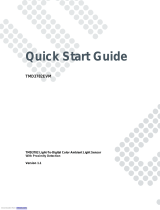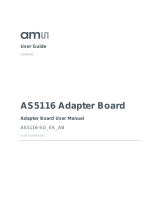AMS TCS3408 is an ALS and color sensor with selective flicker detection that accurately measures light, color, and flicker of light sources. It features wide dynamic range, fast response time, and low power consumption. With its high sensitivity and accuracy, the TCS3408 is ideal for various applications such as display backlight control, ambient light sensing, and color temperature measurement.
AMS TCS3408 is an ALS and color sensor with selective flicker detection that accurately measures light, color, and flicker of light sources. It features wide dynamic range, fast response time, and low power consumption. With its high sensitivity and accuracy, the TCS3408 is ideal for various applications such as display backlight control, ambient light sensing, and color temperature measurement.


















-
 1
1
-
 2
2
-
 3
3
-
 4
4
-
 5
5
-
 6
6
-
 7
7
-
 8
8
-
 9
9
-
 10
10
-
 11
11
-
 12
12
-
 13
13
-
 14
14
-
 15
15
-
 16
16
-
 17
17
-
 18
18
-
 19
19
-
 20
20
AMS TCS3408 User guide
- Type
- User guide
- This manual is also suitable for
AMS TCS3408 is an ALS and color sensor with selective flicker detection that accurately measures light, color, and flicker of light sources. It features wide dynamic range, fast response time, and low power consumption. With its high sensitivity and accuracy, the TCS3408 is ideal for various applications such as display backlight control, ambient light sensing, and color temperature measurement.
Ask a question and I''ll find the answer in the document
Finding information in a document is now easier with AI
Related papers
-
AMS Evaluation Kit for TCS3408 Quick start guide
-
AMS TMD2712 ALS and Proximity Sensor Module User guide
-
AMS TMD2755 Quick start guide
-
AMS TMD2725EvalKit Quick start guide
-
AMS TMG3992 EVM Quick start guide
-
AMS AS621x Demo Kit User guide
-
AMS AS6200Demo Quick start guide
-
AMS AS621x Demo Kit Quick start guide
-
AMS TSL2571 Series Quick start guide
-
AMS TSL2521 Eval Kit User guide
Other documents
-
Osram TMD2621 User guide
-
 amun TMD3782 Light To Digital Color Ambient Light Sensor User guide
amun TMD3782 Light To Digital Color Ambient Light Sensor User guide
-
 AMS OSRAM GROUP AS5116-SO_EK_ST User manual
AMS OSRAM GROUP AS5116-SO_EK_ST User manual
-
 TAOS TSL237S User manual
TAOS TSL237S User manual
-
Texas Instruments bq76PL455EVM and GUI (Rev. A) User guide
-
Silicon Labs UG376 User guide
-
Texas Instruments Sharp LCD BoosterPack (430BOOST-SHARP96) for the LaunchPad User guide
-
Texas Instruments ADS131E08 (Rev. B) User guide
-
Texas Instruments for ADS7041EVM-PDK User guide
-
Texas Instruments ADS5474 ADX Evaluation Board for Interleaving User guide
























